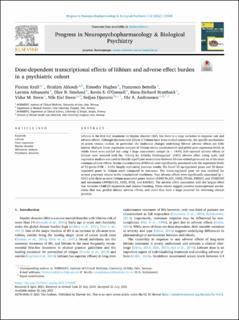| dc.contributor.author | Krull, Florian | |
| dc.contributor.author | Akkouh, Ibrahim Ahmed | |
| dc.contributor.author | Hughes, Timothy | |
| dc.contributor.author | Bettella, Francesco | |
| dc.contributor.author | Athanasiu, Lavinia | |
| dc.contributor.author | Smeland, Olav Bjerkehagen | |
| dc.contributor.author | O'Connell, Kevin Sean | |
| dc.contributor.author | Brattbakk, Hans-Richard | |
| dc.contributor.author | Steen, Vidar Martin | |
| dc.contributor.author | Steen, Nils Eiel | |
| dc.contributor.author | Djurovic, Srdjan | |
| dc.contributor.author | Andreassen, Ole | |
| dc.date.accessioned | 2022-04-01T08:10:09Z | |
| dc.date.available | 2022-04-01T08:10:09Z | |
| dc.date.created | 2022-02-20T17:00:35Z | |
| dc.date.issued | 2022 | |
| dc.identifier.issn | 0278-5846 | |
| dc.identifier.uri | https://hdl.handle.net/11250/2989060 | |
| dc.description.abstract | Lithium is the first-line treatment for bipolar disorder (BD), but there is a large variation in response rate and adverse effects. Although the molecular effects of lithium have been studied extensively, the specific mechanisms of action remain unclear. In particular, the molecular changes underlying lithium adverse effects are little known. Multiple linear regression analyses of lithium serum concentrations and global gene expression levels in whole blood were carried out using a large case-control sample (n = 1450). Self-reported adverse effects of lithium were assessed with the “Udvalg for Kliniske Undersøgelser” (UKU) adverse effect rating scale, and regression analysis was used to identify significant associations between lithium-related genes and six of the most common adverse effects. Serum concentrations of lithium were significantly associated with the expression levels of 52 genes (FDR < 0.01), largely replicating previous results. We found 32 up-regulated genes and 20 down-regulated genes in lithium users compared to non-users. The down-regulated gene set was enriched for several processes related to the translational machinery. Two adverse effects were significantly associated (p < 0.01) with three or more lithium-associated genes: tremor (FAM13A-AS1, FAR2, ITGAX, RWDD1, and STARD10) and xerostomia (ANKRD13A, FAR2, RPS8, and RWDD1). The adverse effect association with the largest effect was between CAMK1D expression and nausea/vomiting. These results suggest putative transcriptional mechanisms that may predict lithium adverse effects, and could thus have a large potential for informing clinical practice. | en_US |
| dc.language.iso | eng | en_US |
| dc.publisher | Elsevier | en_US |
| dc.rights | Navngivelse 4.0 Internasjonal | * |
| dc.rights.uri | http://creativecommons.org/licenses/by/4.0/deed.no | * |
| dc.title | Dose-dependent transcriptional effects of lithium and adverse effect burden in a psychiatric cohort | en_US |
| dc.type | Journal article | en_US |
| dc.type | Peer reviewed | en_US |
| dc.description.version | publishedVersion | en_US |
| dc.rights.holder | Copyright 2021 The Authors | en_US |
| dc.source.articlenumber | 110408 | en_US |
| cristin.ispublished | true | |
| cristin.fulltext | original | |
| cristin.qualitycode | 1 | |
| dc.identifier.doi | 10.1016/j.pnpbp.2021.110408 | |
| dc.identifier.cristin | 2003827 | |
| dc.source.journal | Progress in Neuro-psychopharmacology and Biological Psychiatry | en_US |
| dc.identifier.citation | Progress in Neuro-psychopharmacology and Biological Psychiatry. 2022, 112, 110408. | en_US |
| dc.source.volume | 112 | en_US |

